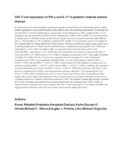| dc.description.abstract | In Plasmodium falciparum holoendemic transmission regions of western Kenya, life-threatening pediatric malaria manifests primarily as severe malarial anemia (SMA, Hb≤6.0 g/dL with any density parasitemia). To determine the role that CD4+ T-cell-driven inflammatory responses have in the pathogenesis of SMA, peripheral CD4+ T-cell populations and their intracellular production of pro-inflammatory cytokines (IFN-γ and IL-17) were characterized in children aged 12–36 months of age stratified into two groups: non-severe malarial anemia (non-SMA, Hb≥6.0 g/dL, n = 50) and SMA (n = 39). In addition, circulating IFN-γ and IL-17 were measured as part of a Cytokine 25-plex Antibody Bead Kit, Human (BioSource™ International). Children with SMA had higher overall proportions of circulating lymphocytes (P = 0.003) and elevated proportions of lymphocytes expressing IFN-γ (P = 0.014) and comparable IL-17 (P = 0.101). In addition, SMA was characterized by decreased memory-like T-cells (CD4+CD45RA-) expressing IL-17 (P = 0.009) and lower mean fluorescence intensity in memory-like CD4+ T-cells for both IFN-γ (P = 0.063) and IL-17 (P = 0.006). Circulating concentrations of IFN-γ were higher in children with SMA (P = 0.009), while IL-17 levels were comparable between the groups (P = 0.164). Furthermore, circulating levels of IFN-γ were negatively correlated with IL-17 levels in both groups of children (SMA: r = -0.610, P = 0.007; and non-SMA: r = -0.516, P = 0.001), while production of both cytokines by lymphocytes were positively correlated (SMA: r = 0.349, P = 0.037; and non-SMA: r = 0.475, P = 0.001). In addition, this correlation was only maintained by the memory-like CD4+ T cells (r = 0.365, P = 0.002) but not the naïve-like CD4+ T cells. However, circulating levels of IFN-γ were only associated with naïve-like CD4+ T cells producing IFN-γ (r = 0.547, P = 0.028), while circulating levels of IL-17 were not associated with any of the cell populations. Taken together, these results suggest that enhanced severity of malarial anemia is associated with higher overall levels of circulating lymphocytes, enhanced intracellular production of IFN-γ by peripheral lymphocytes and high circulating IFN-γ levels. In addition, the observed inverse relationship between the circulating levels of IFN-γ and IL-17 together with the reduction in the levels of memory-like CD4+ T cells expressing IL-17 in children with SMA may suggest possible relocation of these cells in the deeper tissues for their pathological effect. | en_US |

